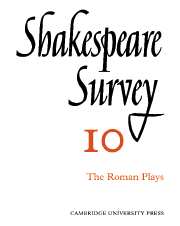Book contents
- Frontmatter
- Shakespeare’s Roman Plays: 1900–1956
- Shakespeare’s ‘Small Latin’—How Much?
- Shakespeare and the Elizabethan Romans
- The Metamorphosis of Violence in Titus Andronicus
- From Plutarch to Shakespeare: A Study of Coriolanus
- The Composition of Titus Andronicus
- Classical Costume in Shakespearian Productions
- Shakespeare’s Use of a Gallery over the Stage
- Lear’s Questions
- “Egregiously an Ass”: The Dark Side of the Moor. A view of Othello’s Mind
- Shakespeare in Schools
- Shakespeare Festival, Toronto, Canada
- International Notes
- Shakespeare Productions in the United Kingdom: 1955
- Drams of Eale, A Review of Recent Productions
- The Year's Contributions to Shakespearian Study 1 Critical Studies
- 2 Shakespeare’s Life, Times and Stage
- 3 Textual Studies
- Books Received
- Index
- Plate Section
The Composition of Titus Andronicus
Published online by Cambridge University Press: 28 March 2007
- Frontmatter
- Shakespeare’s Roman Plays: 1900–1956
- Shakespeare’s ‘Small Latin’—How Much?
- Shakespeare and the Elizabethan Romans
- The Metamorphosis of Violence in Titus Andronicus
- From Plutarch to Shakespeare: A Study of Coriolanus
- The Composition of Titus Andronicus
- Classical Costume in Shakespearian Productions
- Shakespeare’s Use of a Gallery over the Stage
- Lear’s Questions
- “Egregiously an Ass”: The Dark Side of the Moor. A view of Othello’s Mind
- Shakespeare in Schools
- Shakespeare Festival, Toronto, Canada
- International Notes
- Shakespeare Productions in the United Kingdom: 1955
- Drams of Eale, A Review of Recent Productions
- The Year's Contributions to Shakespearian Study 1 Critical Studies
- 2 Shakespeare’s Life, Times and Stage
- 3 Textual Studies
- Books Received
- Index
- Plate Section
Summary
This is not an essay in disintegration. Indeed, the study of Titus Andronicus and other First Folio plays makes me doubt the possibility of disintegrating an Elizabethan play-text to the satisfaction of anyone but the disintegrator and those already predisposed to his view. Yet, while criticizing the methods hitherto used in authorship problems, I shall propose one which has proved valuable in the case of Titus Andronicus and might therefore with profit be applied to other disputed plays. The method is, in the main, stylistic, and the discovery of certain eccentricities in the style of Titus leads to the conclusion that it is either Shakespeare’s first play, an alternative to which I incline, or else the work of more than one author. To refine the second alternative, should this prevail, to establish which authors were concerned in the composition, must await a parallel full-scale investigation of the styles of Shakespeare’s contemporary dramatists. And here I must state my faith that in any play of disputed authorship the most careful sifting of internal evidence cannot satisfactorily assign small patches, or even whole scenes or acts, to particular writers— except possibly in the case of a clear-cut division of work between act and act—since within any play there may be wide and inexplicable variations. Thus in Titus, Peele’s authorship of Act Ⅰ, often suspected on account of the flatness of the verse, its thin diction and Peelean tags, seems confirmed by the abundant alliteration, a device favoured by Peele.
- Type
- Chapter
- Information
- Shakespeare Survey , pp. 60 - 70Publisher: Cambridge University PressPrint publication year: 1957
- 2
- Cited by



